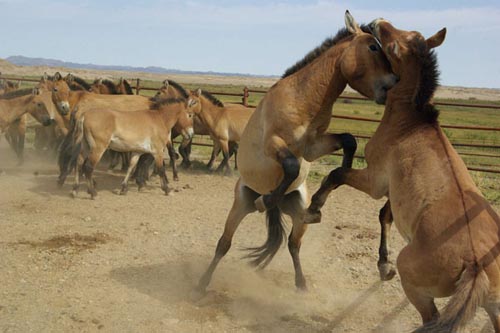
Captive Przewalski's horses are released into nature in Dunhuang, Gansu province, on Thursday. Zhang Yongsheng / for China Daily
A herd of 21 highly-endangered Przewalski's horses were released into the National Nature Reserve in Dunhuang in Northwest China's Gansu province on Thursday, as part of efforts to replenish the animal's numbers in the wild.
The release follows a successful trial that turned seven horses loose in the same area in 2010.
"So far, everything goes well. All the horses have adapted to their new home and none have health problems," said Sun Zhicheng, an official from the nature reserve.
The horses underwent a series of physical examinations when they arrived in Dunhuang on Tuesday after traveling more than 10 hours by road from Wuwei of Gansu, he said.
The Przewalski's horse, with its stocky body and short neck, is the only true living species of wild horse. The rare species, which was once common on the Eurasia continent, was last seen in the wild in 1969. Its dwindling numbers have been blamed on human activity.
At present, there are more than 1,000 Przewalski's horses kept in zoos around the world. In the 1980s, China reintroduced the horse from foreign countries, including the United States and Germany, according to the Gansu Endangered Animal Protection Center under the State Forestry Administration.
In the 1980s the number of captive Przewalski's horses in the center was only 18, there are now 75, including the 21 returned to the wild.
About 300 such horses are now also kept captive in Gansu and the neighboring Xinjiang Uygur autonomous region, according to the center.
"We have taken into full consideration the future reproduction of the horses. The 21 released horses included four males, eight females and nine are immature," said Zhao Chongxue, deputy director of the center.
"I'm full of confidence for the survival of the 21 horses in the wild, as a previous experimental release of seven horses in 2010 was successful. Today, all of those seven horses are healthy and strong in the wild and a little horse was born in July," he said.
But professionals are worried that decreased water in the nature reserve due to years of exploitation of groundwater may pose a threat to the horses living in the wild.
"We dug 10 new springs this year to satisfy those horses and will break ice in winter to ensure their water supply," Sun said.
At present, the ancient horse's survival and reproduction rates in the wild are not high, said Sun Quanhui, an official from the World Society for the Protection of Animals, headquartered in London.
"Long captivity and rather close blood relations among the horses returned to the wild meant it was not easy for them to survive for a long time. So far, there is no stable population of Przewalski's horses in the wild anywhere in the world," he said.
Other countries, such as Russia and Mongolia, are also striving to return the horses to the wild, he said.
"Although the horses are precious, they have not attracted as much attention as pandas in China up to now. The country needs to give more support to try to save this rare horse species," he said.

Copyright ©1999-2011 Chinanews.com. All rights reserved.
Reproduction in whole or in part without permission is prohibited.